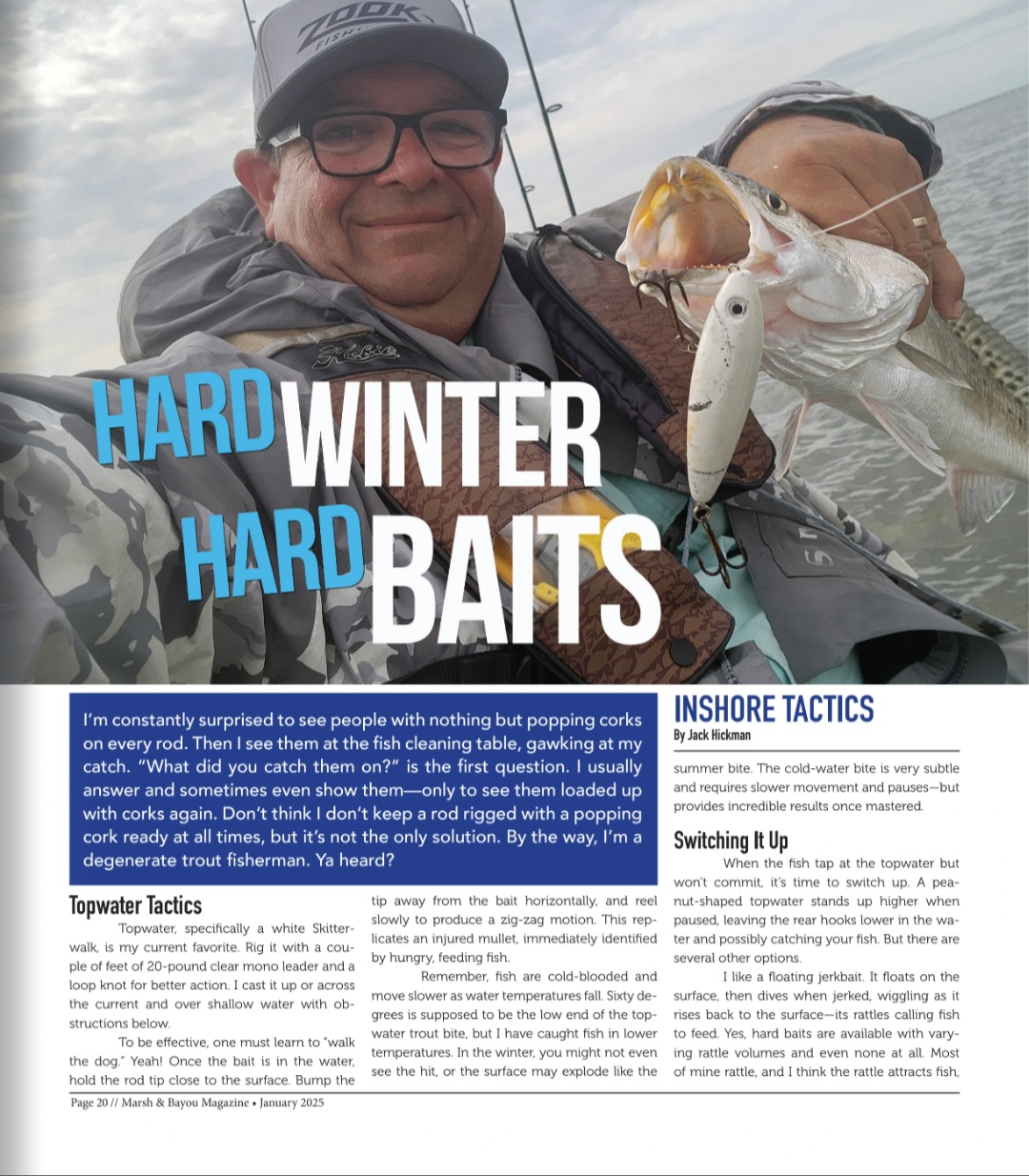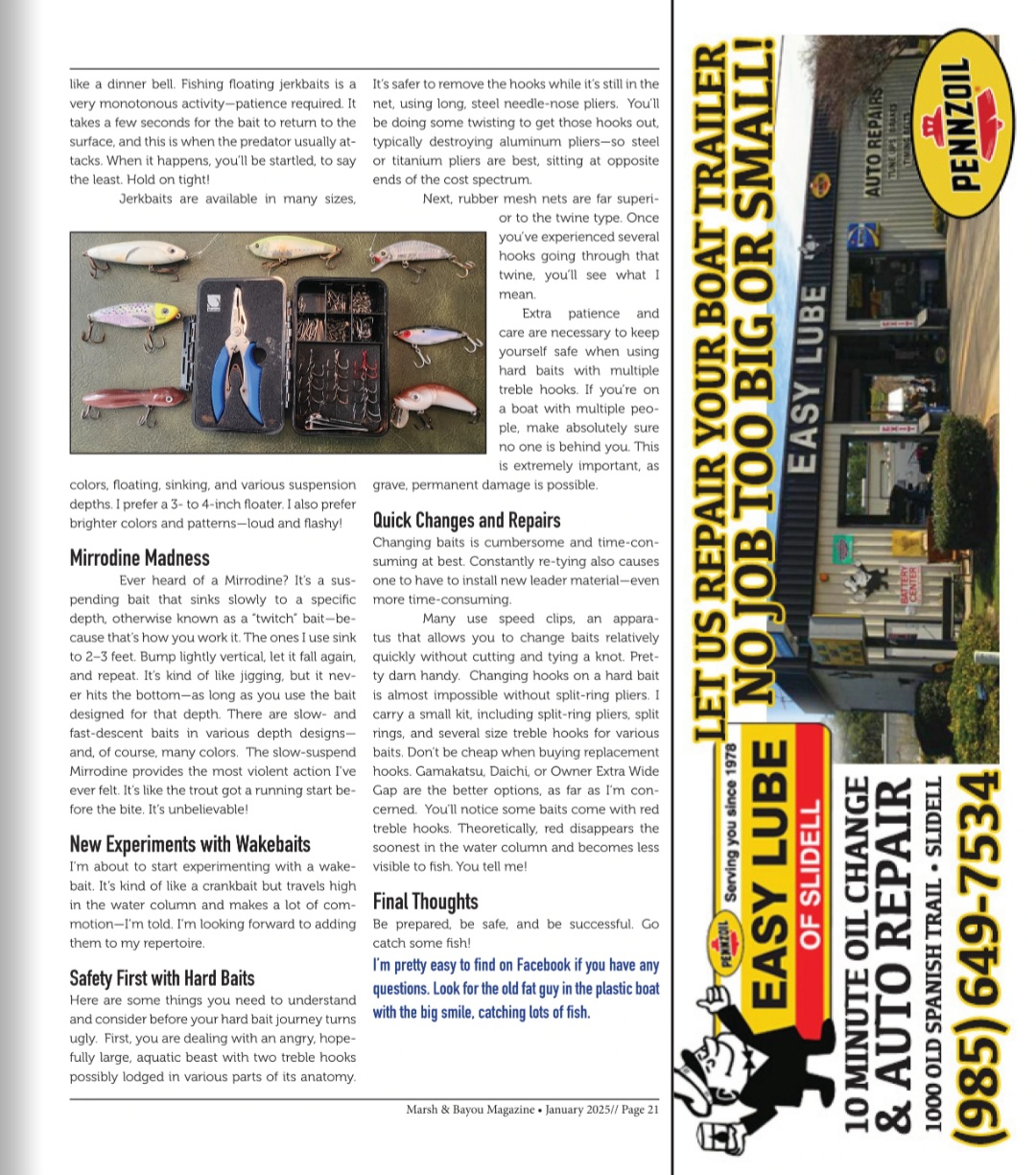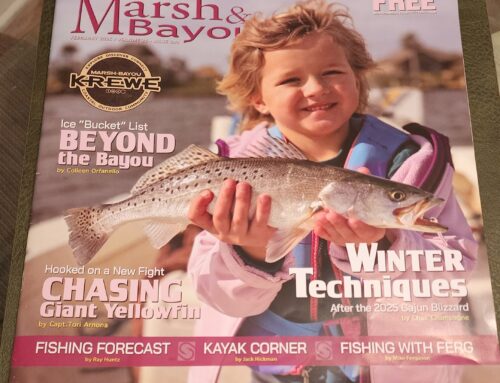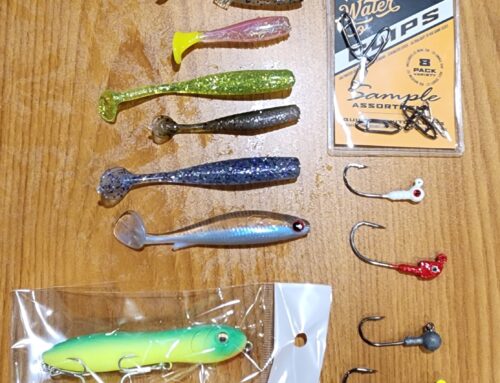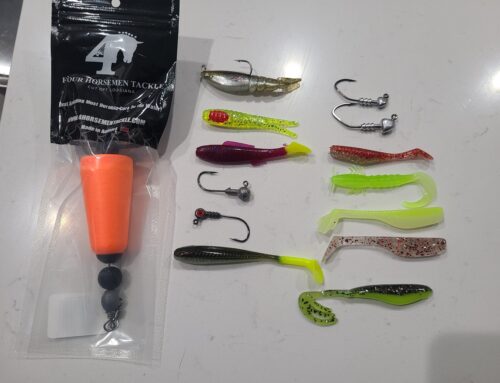I’m constantly surprised to see people with nothing but popping corks on every rod. Then I see them at the fish cleaning table gawking at my catch. What did you catch them on is the first question, and I usually answer and sometimes even show them, only to see them loaded up with corks again. Don’t think I don’t keep a rod rigged with a popping cork ready at all times, but it’s not the only solution. By the way I’m a degenerate trout fisherman. Ya heard?
Topwater, specifically a white Skitterwalk, is my current favorite. Rig it with a couple feet of 20 pound clear mono leader and a loop knot, for better action. I cast it up or across current, and over shallow water with obstruction below. To be effective, one must learn to “walk the dog”. Yeah! Once the baitis in the water, holding rod tip close to the water, bump the tip away from the bait, horizontally, and reel slowly to produce a zig zag motion. This replicates an injured mullet, immediately identified by hungry, feeding fish. Remember, fish are cold blooded and move slower as the water temps fall. 60 degrees is supposed to be the low end of the topwater trout bite, but I have caught in lower temperatures. In the winter, you might not even see the hit, or the surface may explode, like the summer bite. The cold water bite is very subtle and requires slower movement and pauses, but provides incredible results, once mastered.
When the fish tap at the topwater but won’t commit, time to switch up. A peanut shaped topwater stands up higher when paused, leaving the rear hooks lower in the water, and may catch your fish, but there are several other options. I like a floating jerkbait. It floats on the surface, then dives when jerked, wiggling as it rises back to the surface, rattles calling the fish to feed. Yes, hard baits are available with varying rattle volume and none at all. Most of mine rattle and I think the rattle attracts fish, like a dinner bell. Fishing floating jerkbaits is a very monotonous activity, patience required. It takes a few seconds for the bait to return to the surface, and this is when the predator usually attacks. When it happens, you’ll be startled to say the least, hold on tight! Jerkbaits are available in many sizes, colors, floating, sinking and various suspension depths. I prefer a 3 to 4″ floater. I also prefer brighter colors and patterns, loud and flashy!
Ever heard of a Mirrodine? It’s a suspending bait that sinks, slowly, to a specific depth, otherwise known as a “twitch” bait, because that’s how youwork it. The ones I use sink to 2-3 feet, then you bump lightly vertical, and let it fall again, and again and again. It’s kind of like jigging, but it never hits the bottom, as long as you use the bait designed for that depth. There are slow and fast descent baits in various depth designs, and of course many colors. The slow suspend Mirrodine provides the most violent action I’ve ever felt. It’s like the trout got a running start before the bite. It’s unbelievable!
I’m about to start experimenting with a Wakebait. It’s kind of like a crankbait, but travels high in the water column and makes a lot of commotion I’m told. I am looking forward to adding them to my repertoire.
So here’s some things you need to understand and consider before your hard bait journey turns ugly. First, you are dealing with an angry, hopefully large aquatic beast, with two treble hooks possibly lodged in various parts of it’s anatomy. It’s safer to remove the hooks while it’s still in the net, with long steel needle nose pliers. You’ll be doing some twisting to get those hooks out, typically destroying aluminum pliers, so steel or titanium pliers are best, and at the opposite ends of the cost spectrum. Next, rubber mesh nets are far superior to the twine type. Once you’ve experienced several hooks going through that twine, you’ll see. Extra patience and care are necessary to keep yourself safe when using hard baits with multiple treble hooks. If you’re on a boat with multiple people, make damn sure noone is behind you. This is extremely important as grave, permanent damage is possible.
Changing baits is cumbersome and time consuming, at best. Constantly re-tying also causes one to have to install new leader material, even more time consuming. Many use speed clips, an apparatus that allows you to change baits relatively quickly, saw without cutting and tying a knot. Pretty darn handy. Changing hooks on a hard bait is almost impossible, without split ring pliers. I carry a small kit including split ring pliers, split rings, and several size treble hooks for various baits. Don’t be cheap when buying replacement hooks. Gamagatsu, Daichi, or Owner Extra Wide Gap are the better, as far as I’m concerned. You’ll notice some baits come with red treble hooks. Theoretically, red dissapears the soonest in the water column and becomes less visible to fish. You tell me!
Be prepared, be safe, be successful. Go catch some fish! I’m pretty easy to find on Facebook if you have any questions. Look for the old fat guy in the plastic boat with the big smile, catching lots of fish.

